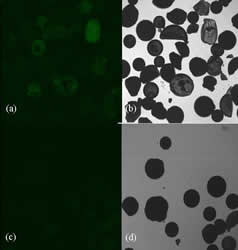Development of Aptamer Based Biosensors
Aptamers are DNA or RNA molecules, which are capable of binding different classes of targets with high affinity and specifity. They bind to the target with high selectivity and specifity because of their specific three-dimensional shape. Binding capacity is the result of oligonucleotides’ three-dimensional conformation not nucleotide base-base complementarity.

Confocal flourescence and light image of trypsine coated magnetic beads treated with round 7 of SELEX library (a, b) and treated with non-selected begining library(c,d).
Aptamers are produced and selected with the use of combinatorial chemistry, technique named in vitro selection, in vitro evolution or SELEX (Systematic Evolution of Ligands by EXponential enrichment).
|